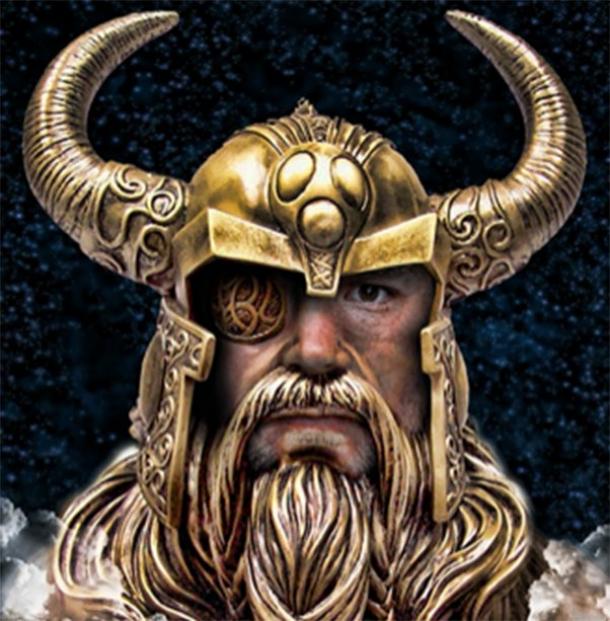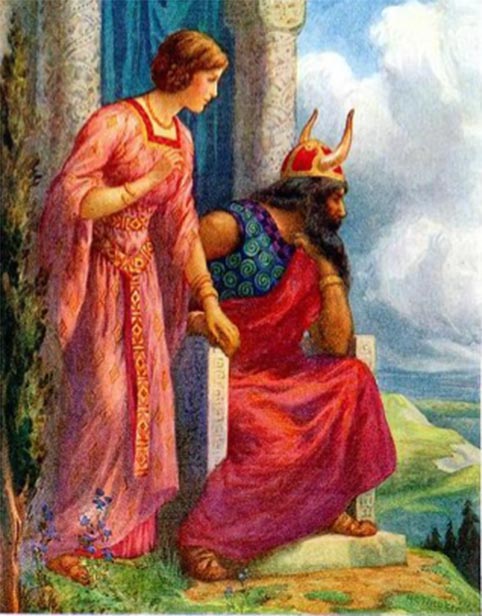
Odin’s Women – Goddesses Ignored, Forgotten and Denied Valhalla
In the Norse myths, the moment Odin sat high on the throne of Asgard, he became all-knowing and ever powerful, as written by Snorri Sturluson in the Prose Edda. He is the Allfather who lives in all ages and watches all of time. Odin controls all things, no matter how great or small. However, his relationships with his wives and his daughters may not have been as all-great or even all-knowing.
Scandinavian mythology, though beautiful in its words and vivid in the landscapes, is cold, brutal, and depressingly direct in the descriptions of the gods, giants, and mortals. It is only in their songs of death that these myths are poetic and beautiful. Much of this probably comes from the cold and barren land itself, which spawned such tales of grief.
Most of the Scandinavian myths, that are known, derive from two collections: The Poetic Edda, which was written some time in 1056 AD, and the Prose Edda, which was written by Snorri Sturluson sometime in the 13 th century. Although Sturluson’s version incorporated some Christian beliefs into his translations, his works are still considered some of the best Icelandic collections of Scandinavian myths to exist.
While Odin is the supreme god of war and father to the slain, he was just as hungry for knowledge. In his legends, he also attained the title of being the god of wisdom and poetry after he hung for nine days, pierced by his own spear over the world tree to memorize 18 runes of sorcery and nine songs of power. He was so obsessed with the knowledge that he traded one of his eyes for a cup of water from the blessed well of wisdom.

Odin, the supreme god of war, gave up one of his eyes for knowledge. (Bart / CC BY-NC 2.0)
Of all the gods, Odin was the master of all. However, unlike other gods, his lovers were secretive and numerous. He had very few wives and hardly any daughters of mention. It was only after his title as the Allfather that everyone; gods, giants, and mortals were called his children.
However, with the limited information that is presented, can a lineage be traced to the true daughters of Odin? Or was the Viking culture so male-dominated, that even the women deities were second place to the male gods?
Odin’s Wives
From the sources that exist, pieces from various Scandinavian folklores can be tied together to create a coherent lineage. Though most of his offspring were men, there was some mention of goddesses that were both his daughter and his wife at the same time.
In other accounts, his daughters appeared as the Valkyries themselves even though most accounts called them his servants. Could it be, that because he was titled the Allfather, all accounts are true?
As mentioned before, Odin was titled the Allfather, to which all children serve him. And by his side sat his wife Frigga, who apparently knew the fates of men. In the translations of all the myths, it appeared that Odin might have had several wives who lived with him at different times or all together at the same time. After all, Odin was also the god of all creation and time.
- The Saga of Gestumblindi and Odin’s Riddles
- Skaði, The Norse ‘Giantess’ with a Godly Vendetta
- The Story of Sif, Powerful Wife of Norse God Thor

Frigga, Odin’s wife shown by his side. (Csemerick / Public Domain)
Odin was married to Frigga the goddess of the sky, fertility, motherhood, love, and the arts; Freyja the goddess of Venir was famous for lust, music, spring, and flowers; Jord the earth goddess who happened to be his daughter and his wife; Gulveig, the sorceress who had a love for gold and was thrown into a fire for her desires only to be reborn three times. Though it has been argued that Frigga, Freyja, and Gulveig may have been the same woman with different names, each deity revealed a slightly different variation that made them stand apart.
The deity whom Odin did not marry but raped, was Rindr the frost giantess and the goddess of women’s protections. From all his encounters and marriages, most of Odin’s offspring were men except for a few who were daughters. Even then, their tales were muted by the masculine gods.
Of Odin’s offspring, his children with Frigga were Baldr, the god of peace and love, Hodr the blind archer, and Hermod the brave. However, due to the complicated natures of the gods, Odin and Frigga’s offspring were the most tragic, leaving only one of their three children alive.
Their beloved Baldr was accidentally killed by their blind elder son Hodr, to which Hermod, their youngest and bravest, was sent to retrieve Baldr’s body in the underworld only to fail as Frigga could not get the world to cry to bring him back. Inevitably, Hodr is killed by Vali, the illegitimate son of Odin who was conceived by the rape of his mother Rindr.
Odin’s Daughters
With his other wives, he produced daughters of note. With his concubine Freyja, the goddess of Venir, they begat Hnoss and Gersemi. Hnoss’s name in Old Norse derives from the term ‘jewel’. Her identical sister Gersemi’s name translates to ‘treasure’. Both women are usually found together for both are desired by all.
These two deities became the goddesses of desire and riches. However, Odin’s marriage to Freyja was one of distance. Odin was rarely around to love her.
She forever cried tears of amber and gold and may have filled her emotional emptiness with the desire for jewelry and gold. She also was known to attempt seduction of dwarfs and night elves to get what she wanted. In the Edda, she also traveled to distant lands, hoping to find Odin again but was never able to find him.

Freyja seeking her husband, Odin. (Meidosensei / Public Domain)
With his wife Jord, he begat Thor and the giantess Grid who became the mother of Vidar. In other myths, Grid saved her half-brother, Thor, when she became aware of Loki’s plans to coerce Thor to fight the giant Geirrod.
She aids Thor by finding him a girdle of might, a magical wand, and magical iron grieves. However, nothing more appears to be mentioned about Grid.
The Valkyries – Odin’s Daughters or Servants?
Though in some cases, Valkyries have appeared either as the daughters of royalty and even the daughters of Odin, they are, in fact, better known as his servants. The Valkyries were virgin warrior women who acted as the immortal messengers of Odin. Mounted on horseback, wearing helmets of gold, and carrying long spears, they were tasked with collecting the fallen from the battlefield to escort their souls to the halls of Valhalla.
The Valkyries were responsible for choosing who died and who lived. They were also called 'the choosers of the slain,' and their shining armor was represented by the numerous vivid flashes of the northern ‘aurora borealis’ skies.
In earlier Germanic pagan accounts, the Valkyries may have been far more terrifying. They may have been the symbols of the ugliness of war as opposed to the glory of it. This is possibly due to a cultural shift towards favoring a warrior culture.

Daughters of Odin, the Valkyries, shown as warriors. (Jappalang / Public Domain)
According to Austrian Germanist Rudolf Simek, The Valkyries were demon devourers of the dead and thrived on blood and carnage. These demons would not only eat the bodies but lay claim to the souls of the fallen.
However, Simek believes the shift occurred from demon to servants of Odin when Valhalla was reimagined. No longer was Valhalla seen as an endless battlefield, but as a paradise for the strongest of warriors.
The demons were then replaced by the shield maidens of Irish lore and became known as they are represented today. However, though the Valkyries changed in their image, and though Valhalla became a place of worship as opposed to a grim and endless battlefield, did this afterlife only encompass men?
- A Jotunn Did Not Have to be Giant to be a Big Problem for Norse Gods
- The Northern Mysteries Current: Futhark and Mystery Schools of the Viking Age
- Going to Hel and Back: The Travel to Helheim Where a Goddess of Darkness Reigned

The Valkyries, Odin’s daughters, took on a new softer look. (Austriacus / Public Domain)
What About the Norse Women and Goddesses?
What becomes clear with most of the Icelandic sagas is that women played minor roles. Even in their forms of goddesses and giantesses, though they may have been the instigators to start the journey, or the evil sorceress to cast the spells, their beauty, sexual allure, and wisdom was still downplayed in comparison to the men.
Even in the myths, slain men were the only ones allowed in the hall of Valhalla. The Valkyries themselves were messengers who could only fetch slain men. Slain women seemed to have only one option, to be taken to the goddess Hel of the Nifeilm underworld, also known in Christianity as ‘hell’.
Most of the famous offspring of Odin were his sons and not his few daughters. Of all the women that were praised, only Freyja and Frigga were mentioned as women of note. Freya’s presence was especially was strong and lasted even after the subjugation of Christianity over the Vikings.
Still, in contemporary Sweden, many words and traditions give praise to her. The reason for this might be an obvious one: most of the Icelandic sagas were written, translated, and rewritten by men.
The Old Norse societies between the 900s AD to 1200s AD had clearly defined roles where men still dominated women. Women were not allowed to partake in raiding parties nor were they allowed to be merchants. Women were legally owned by either their father or husband.
Women were not allowed to participate in political activities nor could they be in any position of power relating to government administration or chieftain. Women were, however, allowed to manage finances, run farms, and become landowners.
Women had equal rights in divorce and were utterly allowed to leave if they felt they were being abused or mistreated. And they were allowed to take their belongings.

Viking women had set roles in society. (Hans Splinter / CC BY-ND 2.0)
When it came to travel, women could accompany their husbands in time of colonization, and in some rare cases, to help with trade. Though most other accounts would state that women were not allowed to travel with merchants, in one account by an Arab traveler named Ibn Fadlin, who in the year 922 witnessed a Russian Viking burial ceremony (he called the RUS burial), he noticed that many women ranging from wives, servants, and slaves appeared alongside the presence of their men.
In one of his most famous accounts, he described when a prominent king died; the slave girls were asked who wished to die with him. When a girl volunteered, she was honored, pampered, and given many drinks to prepare for the ceremony.
Additionally, he spoke of a broad and fowl looking woman to which the other Rus called 'angel of death’. With her, two daughters helped prepare the slave girl for death.
According to Ibn Fadlin,
“…The angel of death spread the bed with coverings we have just mentioned (Byzantium silk). She is in charge of sewing and arranging all these things, and it is she who kills the slave girls. I saw that she was a witch, thick-bodied and sinister…meanwhile, the slave girl who wanted to be killed came and went, entering, in turn, each of the pavilions that had been built, and the master of each pavilion had intercourse with her saying: 'tell your master that I only did this for your love of him.”
Though his account merely spoke of the Russian Vikings, it still held true in revealing an aspect of women’s roles within a Viking culture. An outsider’s perspective of how they were allows significant insight into this hardened culture made from the ice and blood.
If it is true that it is the landscape that makes the culture, then there is no doubt to why the myths and the lifestyle are written in a way of tragic beauty residing among stories and sagas of pain, conflict, and hardship.
It is apparent that the Norse myths focus on the family of Odin and his epic battles against the gods of before and of the coming of the end of Ragnarök, very little is mentioned about his daughters. Odin’s wives appear to gain more attention than his own female offspring. Perhaps that is intentional, given the male-dominated culture, or maybe it is because scholars haven't found the right stories accounting a differing perspective about the Viking gods.

Women looking up to Odin and Frigga with their long hair tied as beards to impersonate men. In Norse mythology,y as in Norse society, women were not recognized in the same light as men. (Bloodofox~commonswiki / Public Domain)
Top image: Representation of the goddesses that were the wives and daughters of Odin. Source: Jozefklopacka / Adobe Stock.
By B.B. Wagner
References
Barber, E. 1995. Women's Work. The First 20,000 years. Women, Cloth, and Society in Early Times. W.W. Norton and Company.
Bulfinch, T. 1969. Bulfinch's Mythology. Spring Books.
Byock, J. 1999. The Saga of The Volsungs. Penguin Books.
Campbell, J. 2008. Hero of a thousand Faces. Novato: New World Library.
Costa, L. 2018. Stravaganza - Norse Mythology - Daughters of Freyja. [Online] Available at: https://stravaganzastravaganza.blogspot.com/2018/03/norse-mythology-daughters-of-freyja.html
Davidson, H. 1982. Scandinavian Mythology. Peter Bedrick Books.
Eisler, R. 1995. The Chalice and the Blade. Harper One.
Geller. 2018. Frigg - Mythology.net. [Online] Available at: https://mythology.net/norse/norse-gods/frigg/
Jochens, J. 1995. Women in Old Norse Society- An indispensable summary of old Norse Society and the role of women in that Society. Cornell University Press.
Jones, G. 1984. A History of the Vikings. New York: Oxford University Press.
McCoy, D. 2012. Hermod - Norse Mythology for Smart People. [Online] Available at: https://norse-mythology.org/hermod/
Seidokna. 2017. OWC: Hnoss and Gersemi. [Online] Available at: https://aminoapps.com/c/pagans-witches/page/blog/owc-hnoss-gersemi/06k3_o0rfkuj6gDxrvKmxWWNRGWEGPgGR7Z
Short, W. 2020. The Role of Women in Viking Society. [Online] Available at: http://www.hurstwic.org/history/articles/society/text/women.htm
Sturluson, S. 2005. The Prose Edda. Penguin Classics.
















Comments
Here’s an easy one. What’s wrong with this picture? https://commons.wikimedia.org/wiki/File:Odin_and_Frigga_by_Harry_George_...
Nobody gets paid to tell the truth.
It is unfortunate too that the author of the article never investigated as recently as the year 1238, when he would have realized that the title of his article is false.
It is unfortunate that the masculine pagan religions in Europe, with religions based on honor , strength and determination were replaced with the socialistic feminism of Christianity.